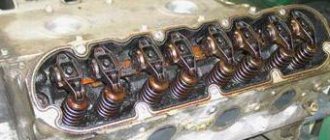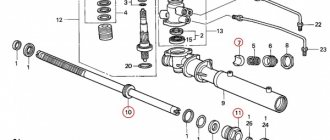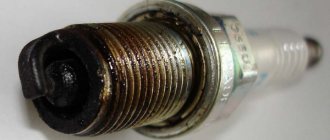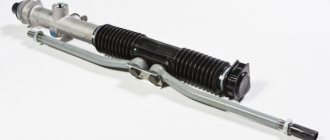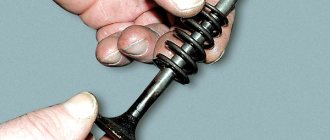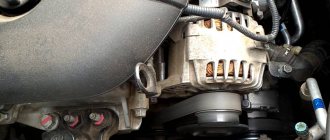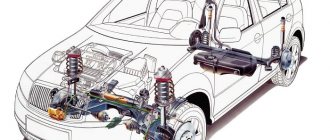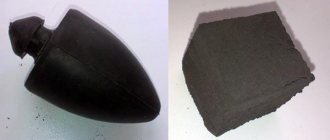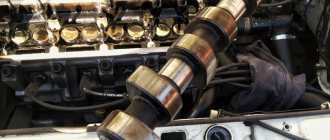Causes of knocking hydraulic compensators
- Engine knocking when starting. If the extraneous noise disappears a few seconds after starting the engine, this is not a sign of a malfunction.
- There is a knocking sound from hydraulic compensators on a cold and warm engine, the noise disappears when the speed increases. The check valve ball may be worn out and the hydraulic compensator will have to be replaced. It is also possible that the hydraulic compensator mechanism may become dirty; cleaning the parts will help.
- The knocking noise only occurs when the engine is warm. Wear and, as a consequence, the appearance of increased gaps between the plunger and the hydraulic compensator sleeve. You will have to change the hydraulic compensator.
- Engine knocking at high speeds. The cause may be too much or too little engine oil. Bring the engine oil level to normal. It is also possible that the oil receiver may be damaged, in which case the faulty parts should be replaced.
- The valves are constantly knocking. The reason may be a gap between the pusher and the camshaft cam. Cleaning or replacing faulty parts will help.
Consequences
Incorrect operation of hydraulic pushers can lead to the following problems:
- reduction in compression and engine power;
- deterioration of its launch;
- burnout of valve plates and seats;
- an increase in shock load on vehicle components and parts, which will lead to their rapid failure;
- increase in fuel consumption.
If the knocking of the hydraulic pushers disappears a few seconds after starting the engine, then in this case there is no need to talk about a malfunction of the mechanism.
Basics of the design and operation of a hydraulic compensator
Configuration
The idea of automatic regulation of thermal clearances can be implemented in two versions: a conventional hydraulic pusher and a hydraulic support. The latter is used in gas distribution modules with rocker arms. On the Lada Priora in the sixteen-valve version, the intake and exhaust are equipped with individual camshafts. The optimal solution for this arrangement is the use of a hydraulic pusher.
Determine which element is knocking
You need to check all hydraulic compensators using this method: press it with a screwdriver. The cam of the element should face the pusher with the back of its head. In good condition, the hydraulic pusher will press with obvious force. Otherwise, the experimental element is broken.
There is another method. One by one, set all the camshaft cams to the upper position and check whether there are gaps between them and the pushers. While pushing down the element, visually compare the speed of its movement relative to the others. If a gap is detected or the rotation speed is higher than normal, disassemble the hydraulic compensator and clean it of dirt. If this does not help, replace it.
The knocking noise of the engine does not go away or appears after warming up
Much more dangerous is the knocking of hydraulic compensators, which appears as it warms up or only intensifies as the power unit reaches operating temperatures. In this case, the hydraulic compensators constantly knock at idle speed of a warm engine; the knock may be present under load, etc. The list of causes for this malfunction is wider than knocking noises on a cold internal combustion engine.
First, you need to make sure that it is the hydraulic compensators that are knocking when hot, since there are many reasons for knocking in the engine. To do this, you need to know how to identify a knocking hydraulic compensator. It is also important to be able to determine which hydraulic compensator is knocking, which will help more accurately localize the fault.
Note that the knocking of compensators has a characteristic sound. The pitch is high, the knock is loud, reminiscent of a metal ball striking another metal part, and is localized under the valve cover. Can be easily heard with a stethoscope. If the main valve knocks constantly, then it may soon become completely jammed or other breakdowns will occur. In such a situation, the engine needs repair; it is possible to replace the hydraulic compensators. In some cases, the seat of the hydraulic compensator is also broken. After the motor heats up, thermal expansion of the parts occurs, and the hydraulic fluid begins to “dangle” at the installation site and knock. A more accurate determination of a knocking main engine is possible after partially disassembling the motor and removing the cover.
As already mentioned, on a cold engine, contamination of the channels can cause knocking, after which the extraneous sound disappears as it warms up. In the case of a hot internal combustion engine, exactly the opposite happens, when, parallel to the increase in temperature, the deposits in the channel soften and shift, completely blocking the supply of lubricant to the main fluid chamber. In this case, it is also recommended to flush the hydraulic compensators and lubrication system, change the engine oil, or clean the engine after disassembling it.
The oil filter should be checked, which may be the cause of insufficient pressure in the lubrication system and, as a result, knocking of the engine when hot. If there is insufficient pressure in the hydraulic compensators, an air lock is created. The oil level in the engine also deserves special attention, which should not be lower or higher than normal (oil overflow into the engine). It should be noted that when cold, at low speeds and problems with the oil level, the HA may not knock. After the engine warms up, the amount of air in the oil increases and a knocking sound from the hydraulic compensators appears, as the oil and air become a compressible mixture. It is also advisable to check the operation of the oil pump and measure the pressure in the lubrication system if problems with the hydraulic fluid appear on a hot engine.
How to eliminate the knocking of hydraulic pushers on Lada Priora
Timely and high-quality maintenance of the engine oil system is the key to flawless operation of the hydraulic compensator mechanism. After all, the unit is designed for use throughout the entire resource of the power plant.
Use of recommended lubricant
When the hydraulic pushers just start knocking, the manufacturer recommends changing the lubricant to a proven option. Therefore, when the question arises of what kind of oil to pour in principle, it is worth analyzing reviews to determine the acceptability of a certain model of oil product for hydraulic compensators.
Of course, the best choice for Lada Priora will be the composition recommended by the manufacturer, specified in the instruction manual. However, not all current popular products are included in the list.
An analysis of opinions shows that, indeed, with the universal viscosity of 10W-40 or 5W-40 specified by the factory, not every oil is suitable. For example, Shell Helix Ultra 5W-40 causes knocking already at 15,000 km, while on Liqui Moly Optimal Synth 5W-40 the hydraulics are silent even at 80,000 km.
Reviews show that it is optimal to choose the following lubricants:
- Total Quartz 9000 Energy 5W-40.
- Mobil Ultra 10W-40.
- Wagner Windigo 10W-40.
Flushing
Many owners, in advanced cases, resort to general engine flushing. However, the effectiveness of such an event in the fight against knocking GCs is low. This is explained by poor oil pumpability in the area of the hydraulic pusher chambers.
If changing the lubricant does not help, the best solution is to remove the cylinder head cover and find which hydraulic compensators on the Lada Priora 16-valve engine are knocking and determine the reason for this. Defective parts are identified by diagnosing running resistance with a wooden wedge. A fast movement speed in comparison with other hydraulic supports indicates wear of the hydraulic module, the presence of a constant gap indicates its coking.
Attention! The wooden wedge must be pressed against the non-working surface of the cams.
Effective removal of carbon deposits inside the cylinders is their local washing. Worn assembly modules cannot be repaired.
Additives
Additive compounds help delay identifying the causes and cleaning the timing belt. There are several products available in the market. The most popular products are from Liqui Moly and XADO. The effectiveness of substances depends on the specific case. Fans of motor additives often equate this class of chemistry with a waste of money.
Everything should be nearby, don’t start without preparation
Lada Priora can serve as an example to consider the replacement process. To avoid unpleasant surprises, any work must be planned and everything necessary must be prepared. In our case we will need:
- Gasket Maker - sealant (anaerobic);
- camshaft plugs and seals;
- 16 INA compensators.
Let's start by disconnecting the battery minus. Then we dismantle the air filter, throttle cables, wires that will interfere with manipulation, injector ignition coils and intake manifold.
Replacing hydraulic compensators on a Priora is complicated by the fact that the manifold mounting bolt is located under the generator.
To get to the hydraulic compensators:
- The generator belt is removed, the generator itself is freed from the mounting bolts and carefully moved to the radiator. Using a wrench with a rotary head, the manifold mounting bolt is unscrewed.
- The ramp with nozzles is dismantled and the air conditioning pipes are disconnected (if equipped).
- The collector is dismantled. First, we lift its left edge and then the entire part, and then we move it to the left.
- The valve cover is removed using a screwdriver inserted into the technological grooves.
- Next, the timing belt is removed, the pulleys, camshaft bed and the shafts themselves are dismantled.
Noises when hot
Hot tapping is more systematic. It is observed even when the engine is already warmed up. The reason for the occurrence of such periodic sounds is the increased gap between the hydraulic compensator sleeve and the plunger. It occurs for the following reasons:
- wear of the hydraulic pusher parts or “sticking” of the valve through which the lubricating fluid passes;
- the use of low-quality motor oil or the wrong choice of its viscosity;
- blockage of oil channels;
- oil filter contamination;
- high air content in the engine oil and, as a result, in the hydraulic pushers themselves;
- flaring of the hydraulic pusher seating area, which expands even more when heated.
In these cases, it may be necessary to replace the hydraulic compensator itself, the oil filter, the oil, or clean the oil channels.
Unlike tapping when cold, in this situation it is not recommended to ignore this malfunction.
Assembly nuances
After replacing 16 hydraulic compensators, everything must be restored to its original form. The most important operations in order:
- We clean and degrease the camshafts and seats of the bed and valve cover, both on the parts and on the engine.
- We change the seals, plugs and put both shafts in place. The inlet has a special belt, which is not present on the outlet. This is its distinctive feature.
- Apply Gasket sealant to the mounting location of the camshaft bed and mount it (no gasket required).
- We treat the fit for the valve cover with sealant and mount it (no gasket required).
- We install injectors, condenser tubes, mount the manifold, generator, its belt, pulleys and timing belt.
- We restore the operation of the throttle valve, filter and connect all the wires.
Replacing hydraulic lifters sometimes results in the engine not starting due to lack of compression. As a rule, hydraulic valves are installed oil-filled and it may happen that due to the incompressibility of compensators, some valves will be open. To avoid this, it is necessary to tighten them with a clamp before installation.
If, when starting the 16-valve Priora engine, you hear knocking noises in the engine compartment, which will disappear as the power plant warms up, then you should check the hydraulic compensators (HC). When every start of a cold engine is accompanied by a knocking sound, this is a clear sign of a worn hydraulic compensator. We will tell you how to replace expansion joints yourself. We will also look at a component such as the cylinder head check valve, which can also cause defects in the operation of compensators.
Hydraulic compensators are sensitive to the quality of lubricant. If mechanical impurities are present in the oil, the part may fail ahead of schedule. Faulty hydraulic compensators cannot be repaired. After installing new compensators, you may be upset by the knocking of the remaining main valves - this is normal, but not for a long time.
Diagnostics and repair
Why do hydraulic lifters knock on the Lada Priora and what to do in this case
First of all, it is worth determining which specific hydraulic pusher is not working correctly, and whether they are the cause of the unpleasant sound. This can be done using acoustic diagnostics or by turning off the engine cylinders alternately. For this, it is advisable to contact a car service or do it yourself. However, trying out repair methods yourself can be more expensive than calling an experienced engine specialist.
Then you need to check the oil pressure in the engine system for compliance with the standards. If it is lower than necessary, then the oil pump or filter may need to be replaced.
Often the cause of incorrect operation of the mechanism is engine oil, which was chosen incorrectly or is present in insufficient quantities. It is necessary to change it to another brand, change its viscosity or add special additives to it that eliminate the knocking of hydraulic pushers.
Sometimes you may notice that oil appears in one of the spark plug wells when the engine is running under heavy load. You need to pull it out with a syringe and clean the spark plugs. Then, to create the required pressure in the system, under the cover of the hydraulic compensators and heads, you need to apply sealant, which was “greedy” when assembling the car at the manufacturer.
Hydraulic pushers do not need any adjustment, since they themselves are able to adapt to the operating mode of the mechanisms.
What to do if hydraulic lifters are knocking on LADA cars
Have you encountered any unusual engine noise? Perhaps it's the hydraulic compensators knocking. This problem occurs most often on Priora, but knocking also appears on other Lada cars (for example, Granta, Kalina, Largus Niva 4x4, Vesta or XRAY). Let's figure out why such a knock appears in the engine and how to deal with it.
The hydraulic compensator (also known as hydraulic pusher) is a cylindrical shape that is located between the camshaft and the valves. They perform two functions: transmitting force from the camshaft to the valves and eliminating gaps in their drive.
Diagram of operation of the hydraulic pusher in the valve mechanism of the VAZ-21126 engine: 1 – valve; 2 – check valve spring; 3 – check valve; 4 – cylinder head; 5 – camshaft cam; 6 – pusher; 7 – plunger; 8 – plunger spring; 9 – sleeve; 10 – check valve body; A, B – hydraulic pusher cavities; B – oil channel.
Hydraulic compensators and “Accent”
The reasons for the knocking are standard here. The owners write that the problem can be solved by changing the oil. More experienced owners believe that if hydraulic compensators knock when cold (Accent is no exception), this is nothing more than a feature of the engines.
But in general, most drivers change oil with a viscosity of up to 5W30, and this allows you to completely get rid of the knocking of these mechanisms in the engine.
Typical faults
Before examining the removed hydraulic compensator, you need to identify the non-functioning element. Compensators are located on the valves, so their number is equal to the number of valves provided on the engine. The check can be done without removing the camshaft. But first you need to understand why even new elements fail. There are 4 main faults.
- The gap provided between the plunger itself and its bushing increases. As a result, oil will begin to leak. The compensator will not be able, so to speak, to select thermal gaps;
- The valve does not close properly. This happens rarely, but it should not be ruled out. Because of this, the required pressure cannot be created between the plunger and the bushing;
- Jamming of the plunger pair. The way the sleeve works is that it should move freely relative to the installed plunger. If this freedom is not there, hello jamming;
- Blockages. Oil channels become dirty. Therefore, hydraulic compensators (HC) cannot work.
Is it possible to drive with knocking hydraulic lifters?
Many drivers are interested in the question of whether it is possible to drive with knocking hydraulic compensators and what consequences this can lead to. Let's answer it right away - it is possible, but it is not advisable, since the car will be plagued by a number of problems . In particular:
- loss of power;
- loss of control elasticity (the car will respond worse to steering);
- unenvironmental friendliness (unhealthy exhaust plume from the rear);
- excessive fuel consumption may occur;
- increased vibration;
- additional noise under the hood.
Accordingly, during the operation of a faulty engine there is a chance to “finish off” it completely. Therefore, it is strictly not recommended to drive with faulty engine components. After all, sooner or later it will fail. And the sooner you start repair work, the cheaper and easier it will cost you.
Lada Priora is equipped with a VAZ 21126 engine with an automatic gas distribution mechanism adjustment system. The gap between the camshaft cam and the valve stem is selected by a hydraulic tappet, the successful operation of which is ensured by the engine oil system. The mechanism allows you to avoid making various types of adjustments in the timing belt, reduces fuel consumption and increases the efficiency of the power plant. Fundamentals of the design and operation of a hydraulic compensator
Checking the cylinder head check valve
When disassembling the pusher, you will come across a cylinder head check valve, which contains a ball with a spring. Inspect the cylinder head check valve; if these elements are damaged, then only replacing the pusher will help. The cylinder head check valve along with its components can be replaced entirely, but these parts cannot be found in every car store. They are not in demand, as it rarely fails.
When you inspect the check valve, check whether it is dry or not. If the hydraulic compensator is working properly, then the check valve should be in oil. You can pour lubricant into it and see why the oil leaves.
What knocks when a Priora 16 valve engine is hot?
- Registration
- Entrance
- To the beginning of the forum
- Forum Rules
- Old design
- FAQ
- Search
- Users
- List of forums AUTOLADA.RU
- “Tenth” family (VAZ-2110, VAZ-2111, VAZ-2112) and LADA PRIORA
HELP I don’t know what to do.
remove the valve covers, measure the gaps, if everything is ok, then open the pan. and then according to the situation.
Hello. I have a problem, the engine was knocking. VAZ-21102, mileage 60,000 km. I filled it with Castrol synthetic oil, washed the engine with flushing oil and filled it with ZIk semi-synthetic. I hadn’t driven even 1000 km before I noticed a knocking noise. The knocking is not constant for two seconds, knocking for two seconds and so on, frequency The knocking noise is much lower than the crankshaft rotation speed, it does not knock on a cold engine, the knocking appears when the engine warms up to 50-60 degrees, and is especially loud on a fully warmed-up engine. The knock is metallic but not loud. It is heard only at idle speed at 800-1000, at As the speed increases, the knocking is not audible. Traction, dynamics and consumption are normal as usual. Specialist. He said that either the piston or the connecting rod was damaged, but he would be able to establish it for sure only after disassembling the engine. HELP I don’t know what to do.
On my previous car, VAZ 21099, I had everything exactly like yours:
periodic metallic knocking, and only when the engine is warm and at idle speed.
When opened, one of the pistons turned out to be bent.
Result: replacement of pistons and pins
I bought the car new, for maintenance, I didn’t spare money on consumables, I only filled it with synthetic Castrol.
maybe the hydrik died
I have a problem, the engine is knocking. VAZ-21102
The knocking is not constant for two seconds, it knocks for two seconds, no, and so on, the knocking frequency is much less than the crankshaft rotation speed, it does not knock on a cold engine, the knocking appears when the engine warms up to 50-60 degrees, and is especially loud when the engine is fully warmed up. The knock is metallic but not loud .Audible only at idle at rpm 800-1000, when the rpm increases the knocking is not heard
The camshaft rotates twice as slow as the crankshaft. Most likely a pusher. You need to take some long screwdriver, put it on different parts of the head and listen with your ear on the other side of the screwdriver. Or what is long and hard at hand, for example the handle of a shovel.
And by engine knock, they mean another knock. It cannot be confused with any knock.
Here, perhaps the new oil washed away the varnish deposits in the head, and something got too loose. This is usually how the pushers knock. And if this is so, then nothing bad will happen except a knock.
number 29
Nik77
I still think that it is the valve pusher that is knocking on its own, possibly the adjusting washer in the recess of the pusher. If there had been a knock from the large gap between the cam and the pusher, it would not have disappeared.
2. In the VAZ 21099/»>VAZ 21099i engine manufactured in 2001 (mileage 22 thousand km), one or two minutes after a cold start, extraneous sounds appear, reminiscent of detonation. They do not coincide with the frequency of the timing noise, which occurs at regular intervals, weakens as the engine warms up, and disappears when operating temperature is reached. At the service station, the gaps were checked - they were normal, and the extraneous noise was explained as a consequence of some modernization of the timing belt, which VAZ carried out recently. ZR magazine spoke about the modernization of the timing belt carried out by VAZ. A sphere is introduced on the inside of the pusher in the area of its contact with the end of the valve stem. This reduced the amount of lateral force acting on the valve and reduced the noise level
Timing belt and increased the service life of the guide bushings. On the VAZ 2110 and VAZ 2111 engines, a 2110 camshaft with an increased intake cam height appeared, which increased power by about 2 kW compared to the 2108 camshaft. However, upgrading the timing belt has nothing to do with extraneous noise from your engine. Most likely, this is a special case caused by some deviation from the requirements of the technical documentation. Obviously, it makes sense to conduct audio diagnostics of the engine using a stethoscope and localize the zone of “non-functional” sound. After this, you can look for a solution: partial or complete disassembly of the engine with inspection and replacement of parts is not excluded.
Pay attention to the words reduced the timing noise level
, i.e. It was bigger before and didn’t completely disappear.
You can add thicker oil and the knocking noise should disappear.
Valve knocking is usually a consequence of excessive clearances in the drive. It does not disappear when the speed changes smoothly. Conclusion: adjustment is necessary. But in the engines of front-wheel drive VAZ cars there is a source of similar mild knocking: the valve tappets sway during operation. The sound may come and go. This is an innate feature of the engine. However, harmless? Let's close our eyes to her.
Knocking after replacement
Usually new parts don't knock.
If you still hear sounds, then this is a manufacturing defect or a problem with the valves. In order to perform an accurate diagnosis and make sure that there is nothing wrong with the valves, it is necessary to check their fastenings. There is a possibility that the parts did not shrink as required. We simply tighten them and thereby remove the knock of the hydraulic compensator.
What's the result?
Taking into account the above information, we can conclude that there are many reasons for knocking hydraulic compensators. In some cases, it even happens that new hydraulic compensators are knocking. This happens when, in parallel, the engine oil was incorrectly selected, the oil filter is clogged, there are problems with the cleanliness of the lubrication system or the oil pump, or there are hidden or obvious engine problems that have not been eliminated.
Additionally, it is not recommended to immediately disassemble the internal combustion engine yourself for diagnostics, replacement or washing of hydraulic mounts without proper experience. The fact is that the cause of the knocking must be accurately established. There are quite common cases when, after washing and cleaning the hydraulic compensators, as well as the channels of the lubrication system, the knocking still remains. In such a situation, only professional engine diagnostics can help avoid possible consequences and unplanned financial costs.
Hydraulic compensators: what they are, what function they perform, hydraulic compensator malfunctions and symptoms. Do-it-yourself repair and washing of hydraulic compensators.
Valves knock on a cold engine or after warming up the engine: possible causes of valve mechanism knocking. Fault diagnosis, useful tips.
The most common causes of engine knocking are: piston knock, connecting rod knock, crankshaft knock. What to do if the engine suddenly starts knocking while driving.
Why a cold engine may knock: various malfunctions. Analysis of the nature of the knock in the power unit: ringing, metallic, muffled, etc.
What can knock, whistle, rustle and make other extraneous sounds under the hood after starting the engine. Diagnostics and determination of faults.
The appearance of knocking noises in different diesel operating modes. Fault diagnosis. The nature of the knocks of the crank mechanism, timing gear, and fuel equipment.
Determining the source of the knock
It happens that a knock comes from the engine compartment. Only the driver may not immediately understand what exactly is the reason and who is the source of this noise. You should not immediately blame the valves, since they are not the only ones capable of making knocks.
It is quite difficult for a novice motorist, in the absence of experience in operating and repairing a car, to immediately determine what kind of breakdown or malfunction provoked the occurrence of noises and knocks. Sounds uncharacteristic of a working engine can come from bearings, belts, crankshafts, and the valves themselves. Moreover, in the latter case, we hear a fairly clear and easily audible sound, accompanied by a metallic knock. And it comes from the gas distribution mechanism.
Another characteristic feature of valve knock is that it does not stop, depending on the speed. That is, the knocking will persist when the engine is running at low speeds, and also when the driver, by pressing the gas pedal, increases the engine speed.
An ordinary driver is unlikely to be able to simply tell by ear that a valve has failed.
But still, self-diagnosis is quite possible. To do this you need to do the following:
- open the hood;
- unscrew the plug through which engine oil is poured;
- leave the engine running;
- listen; listen
- if the noise increases, the fault is in the valves;
- or take a stethoscope;
- apply the tool to the area where the noise is coming from;
- listen; listen
- draw appropriate conclusions.
This is just an approximate diagram of how to identify a breakdown and make a diagnosis practically in the field. Of course, it is often best to contact a car service center and undergo a comprehensive diagnosis. You can't joke with faulty valves.
As a consequence, you may encounter breakdown of the valves themselves, disruption of the timing belt, increased fuel and oil consumption, loss of power, and even failure of the engine itself.
The longer you ignore the problem, the more severe and expensive the consequences may end up being. If you hear a metallic knock while warming up or accelerating your car, go to a garage or service station. Don't delay diagnostics.
Why the fuss
First, let's describe the possible reasons why hydraulic compensators usually knock. All of them come in two types: related to the design of the unit itself, or dependent on the supply of oil from the rest of the engine. So, let's list first the first, then the second. Malfunctions of the plunger mechanism:
- wear, defects in the surfaces of parts of the assembly;
- oil supply valve jamming;
- contamination or deposits on parts.
Also find out why valves are knocking and about replacing front shock absorbers.
Next, interruptions of the second type, when the valve hydraulic compensators knock due to poor oil supply from the engine:
- air or dirt entering the oil channel;
- oil filter clogged;
- poor operation of the oil pump;
- violation of the properties of the oil.
The consequence of all this is a knocking sound similar to the well-known valve tapping. It is a clear, mid-range metallic sound. You can also understand how hydraulic lifters knock in a car from a video from the Internet.
Also, car enthusiasts often encounter the appearance of the notorious knocking noise either only with a hot engine or only with a cold one. Let's try to differentiate the prerequisites for sounds according to these two types.
If hydraulic compensators (HC) knock, as they say, when cold, the roots of this phenomenon are as follows.
- The valve on one or several components does not hold, oil leaks, the hydraulic fluid is air-filled. But when the oil warms up, it displaces air and the sound disappears.
- The oil supply channel to the unit is clogged. As it warmed up, the clog dissolved in the oil.
- It's freezing outside and the engine oil is frozen. This is one of the main safe reasons why a problem sometimes arises on a cold engine.
- The oil filter is clogged. On a hot engine, however, the situation improved.
How to identify a faulty hydraulic compensator
Before work, analyze the wear of all pushers, otherwise the case where someone changed the working compensators will repeat. The search for knocking hydraulic compensators of Priora 16 valves involves conducting several experiments or tests. It is basically calculated that Priora hydraulic pushers operate for 100 thousand kilometers.
These parts may rattle when starting a cold engine, and then continue to make noise even when the engine warms up. Knowing about this malfunction, follow these steps to identify faulty Priora hydraulic pushers:
- Check the main valve ball valve. If it is worn out, then nothing can be done - the hydraulic valve will have to be changed and a new part installed in its place.
- The internal cavity of the pusher is contaminated with used grease or oil. If the cases are not critical, you can wash the hydraulics and then coat everything inside with a good oil composition.
- A couple of plungers are worn out - these are two small cylinders. The part cannot be repaired, so it will also have to be replaced.
These signs appear when the hydraulic valves knock while the engine is cold, as well as after it has warmed up, but they quiet down at high speeds. There is another way that will help identify faulty hydraulic pushers. It touches the spring - it is responsible for ensuring that the small parts return to their place whenever the valve needs to be returned back, closing the hole.
By the way, let’s talk about why Priora hydraulics can knock after repair work:
- If new parts make a sound, they are still falling into place - after a couple of engine starts this sound will not be there.
- If the knocking noise appears after changing the oil, the reason is poor-quality oil or a bad/worn out filter.
- Finally, after the car has been left alone for a long time, this piercing sound may also appear. Over time it will disappear. It's just that the oil has drained from the working chambers, and they need to be filled before starting everyday operation without knocking, as well as other signs of malfunctions that can be scary.
Knocks when the engine is cold, what to do
Please note that by starting a cold engine, you are subjecting it to a significant test. This does not mean at all that you cannot run it in frosty weather. It’s just that all the insides harden, the movements of parts are constrained, even “wooden”. They need to warm up in order to return to normal - then the gaps and other parameters will return to operating parameters.
Realizing the severity of the work that the engine does in the cold, we can talk in detail about the reasons why the hydraulic pushers of a cold sixteen-valve Priora engine knock:
- The engine oil life is coming to an end. The oil is of poor quality. The oil is contaminated with engine operating products.
- The viscosity of the engine oil is not suitable for the engine. If it is too soft, the hydraulics will literally “break out” of their positions, which will damage their springs.
- If the oil is too thick, the hydraulic boosters will physically be unable to push the valve.
- The oil system is clogged. If the cross-section through which the valve passes is reduced, the pressure inside the hydraulic tappet decreases and it produces less power during operation.
- The main oil line does not support high pressure. This can be recognized by the burning light indicating the oil level on the dashboard.
- The plunger inside the main valve is jammed. This can happen due to carbon deposits accumulated inside.
- The plunger is worn out. If the check valve leaks, there can be no talk of any high pressure that the hydraulic fluid exerts on the valve.
The knock does not go away or appears on a hot engine
When the engine temperature has gradually risen to operating temperature, the knocking noise may remain. On the contrary, it can suddenly appear. The cause could be any problem typical of knocking on a cold Priora engine. But due to the specifics, two more reasons can be named that cause the knocking of hydraulic pushers in warm Priora engines:
- High or low oil level. When there is too much oil, it doesn't provide room to work. If it is too small, there will not be enough pressure to push the valve.
- The hydraulic wells have expanded due to an overheated engine. Small parts will “walk” in them, and then even go down with a figure eight. Because of this, all the force that they could exert on the valve will be extinguished. Cool down the engine.
